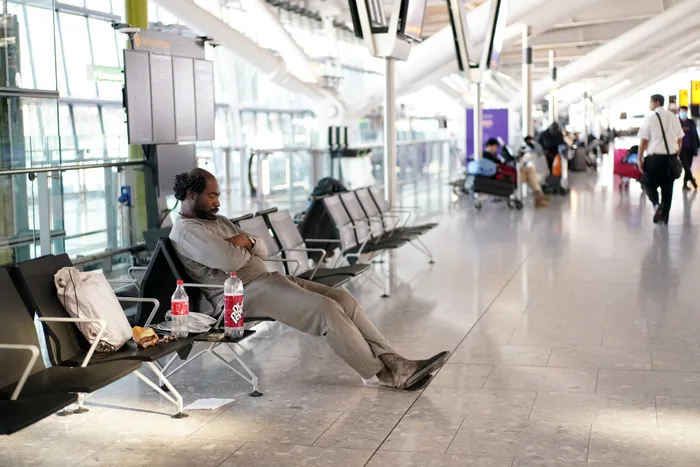At Heathrow Airport there are no checks and no tests, say frustrated passengers

At a time when the nation is in lockdown, the very fact that these airports remain open to commercial flights is surely questionable enough. Picture: Reuters At a time when the nation is in lockdown, the very fact that these airports remain open to commercial flights is surely questionable enough. Picture: Reuters
London - Even the blue face mask covering the Iranian-British businessman’s face couldn’t conceal his consternation as he emerged into the arrivals hall at Heathrow Airport.
Before boarding his Iran Air flight from Tehran, Farzad Parhizkar’s temperature – and those of the other 80 or so passengers – was checked by a laser-beam thermometer, he told me.
They had also been obliged to fill in a form giving such details as their name and address, destination, reason for travel, and whether they had any symptoms of coronavirus.
"Then, when I arrive here in London, there is nothing at all," he said, his eyebrows raising above the mask.
"There was no temperature check, no questions about my health, no advice on how to avoid catching the virus. Nothing. Everything was all just like the world is normal."
It was a criticism I heard repeatedly at Heathrow on Monday and on Sunday as I spoke to some of the 15 000 travellers who are – by Health Secretary Matt Hancock’s latest estimate – still flying into Britain every day.
Of these, the Department for Transport claims, about 10 000 are landing at London’s main hub, while others are coming in through Gatwick, Manchester and Birmingham.
At a time when the nation is in lockdown, the very fact that these airports remain open to commercial flights is surely questionable enough.
That we are continuing to welcome passengers from countries such as Iran, where the official Covid-19 death rate stood on Monday at 5 118 (though many believe the mullahs are lying and that it is considerably higher) seems like utter madness.
On Monday morning, flights also arrived from New York – the city with the world’s highest number of coronavirus deaths, 13 869 – Los Angeles (California, 1 072 deaths), Chicago (Illinois, 1 290), Miami (Florida, 764), Dallas (Texas, 467) and Washington DC (624).
Later, planes were due in from Rome, Madrid, and Paris, three capitals at the epicentre of this pandemic, as well as from Tokyo, Lagos, Lisbon and Ahmedabad in India.
According to Heathrow’s website, the purpose of keeping the airport open is to help repatriate British citizens and import vital freight, such as medical equipment and food. It points out that traffic has fallen by 75% while cargo has increased by 200%.
No one doubts these statistics. In fact, judging by the two days I spent at Heathrow, Hancock’s 10 000 figure may now be an over-estimation. Of the five terminals, only numbers 2 and 5 remain in use, and they are eerily quiet.
No cafes or shops are open, except the chemist, no taxis line the ranks, you see very few staff, just a few cleaners and security guards milling about. Disconcertingly, given that terrorists must surely be looking to exploit this vacuum, there is no visible police presence.
It is like a scene from Contagion, the dystopian film about a global pandemic that was released nine years ago – and has turned out to be uncannily accurate.
However, while Heathrow’s traffic has dropped dramatically – just 60 flights were due to arrive on Monday, less than a tenth of the number on any ordinary Monday – some of the passengers I met certainly weren’t making essential journeys.
Take 49-year-old Mr Parhizkar. A travelling furniture salesmen, his business takes him between Iran and Europe. He was passing through London – where he had to stay overnight – on his way to trade in Sweden, simply because he can no longer fly there directly.
Had he been selling furniture from a shop in Britain, of course, his business would be closed.
Others making the six-and-a-half-hour journey from Iran included a couple visiting relatives in London (they wandered around the terminal, looking forlornly for transport into the city), a woman with two children who had been to see her ailing mother, and a Reading-based Iranian heating engineer who had also been with his sick mother.
They were, at least, impressed with the safety precautions on the flight. The attendants wore masks and regularly proffered hand sanitiser, they said. Passengers not travelling together were encouraged to space themselves out by leaving seats empty, which was relatively easy as the 280-seat Airbus was only about one-third full.
But surely there are obvious perils in allowing people to travel here from Iran, where the safety standards set by the authorities and the manner in which people are interpreting them, differ markedly from our own?
"From what I saw, people in Britain are much more cautious about the virus than they are in Iran," said the 55-year-old heating engineer, who gave only his first name, Babak.
"People do practise social distancing there, but it’s far more casual." He suggested this might be because Iran has a much younger population than Britain. Whatever the reason, I saw first-hand what he meant. On several occasions, at the airport, I had to warn over-friendly Iranians not to come within two metres of me.